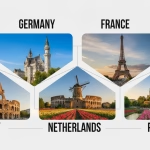Excited to transform your travel enthusiasm into a thriving business in Poland? Dive into our guide and start your travel business journey today!

Poland, a nation blessed with captivating landscapes, a rich historical legacy, and a vibrant cultural scene, has become an irresistible magnet for global travelers. With its origins dating back to 1139, Poland is a treasure trove of historical gems, including renowned landmarks like the medieval Old Town in Krakow, the majestic Wawel Castle, and the poignant Auschwitz-Birkenau Memorial.
If you are genuinely captivated by the charm of travel and possess a strong aspiration to introduce others to the beauty and appeal of Poland, the idea of establishing a travel business in this captivating nation can be deeply personally rewarding and potentially profitable. To help you take the first step, we have compiled a guide with all the information you might need. We will help you navigate the essential processes and provide invaluable insights, enabling you to commence your journey into the world of travel entrepreneurship within Poland.
Research and Planning
Market Research
Conducting Comprehensive Market Research
Start by collecting data on the Polish travel industry. Understand the current market size, trends, and growth potential. Analyze traveler demographics, including age, preferences, and spending habits. Identify popular destinations and types of travel experiences in demand.
Identifying Trends and Opportunities
Stay updated on emerging trends, such as eco-tourism, adventure travel, or wellness tourism.
Look for gaps in the market, underserved niches, or unique experiences you can offer.
Choosing Your Niche
Identifying Your Ideal Customer
Create customer personas to define your target audience. Consider factors like age, interests, and travel preferences. Determine whether you’ll cater to solo travelers, families, luxury seekers, or budget-conscious individuals.
Defining Your Unique Selling Proposition (USP)
Identify what sets your travel business apart from competitors. Your USP could be specialized knowledge of a specific region, unique travel experiences, or exceptional customer service.
Creating a Business Plan
Crafting a Detailed Business Plan
Outline your business goals and objectives. Be specific about what you want to achieve.
Include a mission statement that reflects your business’s purpose and values.
Financial Projections and Budgeting
Prepare financial forecasts, including income statements, balance sheets, and cash flow projections. Develop a budget that allocates funds for marketing, operations, and growth initiatives.
Legal and Regulatory Considerations
Business Registration
Registering Your Travel Business
Choose a suitable legal structure for your business, such as a sole proprietorship, LLC, or corporation. Register your business with the appropriate government authorities, like the National Court Register in Poland.
Choosing the Right Business Structure
Consider consulting with a legal advisor to select the structure that offers the best liability protection and tax advantages. Ensure that your chosen structure aligns with your long-term business goals.
Acquiring the Necessary Permits and Licenses
Determine which permits and licenses are required for your specific type of travel business. This may include travel agency licenses, tour operator permits, or specific certifications for certain activities, such as adventure tourism.

Financial Compliance
Managing Finances Effectively
Set up a business bank account to separate personal and business finances. Keep meticulous financial records, including income, expenses, and receipts.
Tax Obligations and Reporting
Understand your tax obligations, including VAT (Value Added Tax) in Poland. Consider hiring an accountant or tax professional to ensure compliance and minimize tax liability.
Seeking Legal Counsel
If you’re unsure about legal matters, consult with an attorney who specializes in business law. Legal advice can help you navigate complex regulations and avoid costly mistakes.
Building Your Travel Network
Establishing Partnerships
Forging Alliances with Hotels, Airlines, and Attractions
Reach out to hotels, airlines, and local attractions to negotiate partnerships and access exclusive deals for your customers. Leverage your connections and industry knowledge to secure favorable terms.
Negotiating Favorable Agreements
Work on mutually beneficial agreements that provide value to both your travel business and partners. Ensure that agreements are clear, legal, and well-documented to avoid misunderstandings.
Utilizing Technology
Developing an Online Presence
Invest in a professional website that showcases your travel offerings, including detailed itineraries, pricing, and customer testimonials. Ensure that your website is mobile-responsive for travelers on the go.
Leveraging Social Media and Online Marketing
Create and maintain active social media profiles on platforms like Facebook, Instagram, and Twitter. Share engaging content, including travel tips, destination highlights, and customer stories. Use social media advertising and pay-per-click (PPC) campaigns to reach a wider audience.
Marketing and Promotion
Website Development
Building a User-Friendly Website
Hire a professional web developer to create a visually appealing, easy-to-navigate website.
Optimize loading times and ensure that the website is user-friendly across various devices.
Showcasing Services and Packages
Clearly present your travel packages, including detailed itineraries, pricing, and inclusions.
Use high-quality images and videos to entice potential customers.
Integrating Online Booking
Implement a secure online booking system that allows customers to make reservations directly from your website. Provide real-time availability and instant confirmation to enhance the booking experience.
Content Marketing
Creating Engaging Travel Content
Develop a content strategy that includes blog posts, travel guides, videos, and podcasts. Share valuable information about destinations, travel tips, and insider insights.
Blogging, Videos, and Guides
Regularly publish informative blog posts and articles that showcase your expertise. Create engaging travel videos and guides that provide valuable insights and entertainment.
Enhancing SEO for Visibility
Optimize your website for search engines (SEO) to improve organic search rankings. Use relevant keywords, meta tags, and high-quality backlinks to boost your website’s visibility.
Social Media Engagement
Running Targeted Advertising Campaigns
Use social media advertising tools to target specific demographics and interests. A/B test ad creatives and analyze campaign performance to refine your approach.
Engaging with Potential Customers
Respond promptly to inquiries and comments on social media platforms. Encourage user-generated content by featuring customer photos and reviews.

Providing Exceptional Customer Service
Customer Communication
Promptly Responding to Inquiries
Establish a communication protocol to respond to customer inquiries within a specified timeframe. Use email, phone, and chat support to accommodate different communication preferences.
Handling Customer Complaints
Develop a structured process for addressing customer complaints or issues. Empower your team to resolve problems effectively and provide compensation when necessary.
Building Trust through Transparent Communication
Be transparent about your services, pricing, and policies. Clearly communicate any changes, such as itinerary alterations or cancellations, to customers.
Reviews and Testimonials
Encouraging and Managing Customer Reviews
Encourage satisfied customers to leave positive reviews on platforms like TripAdvisor, Google, and Yelp.
Respond to all reviews, both positive and negative, professionally and empathetically.
Addressing Negative Reviews
Address negative reviews constructively and offer solutions to resolve issues.
Use negative feedback as an opportunity to improve your services and prevent future problems.
Financial Management
Budgeting
Developing a Comprehensive Budget
Create a detailed budget that accounts for all anticipated expenses, including marketing, operations, and overhead. Monitor your budget regularly and adjust it as needed to stay within financial goals.
Monitoring Income and Expenses
Implement accounting software to track income and expenses accurately. Categorize expenses to identify areas where cost-cutting is possible.
Allocating Resources Wisely
Prioritize investments that have the most significant impact on your business, such as marketing initiatives that generate high ROI. Be mindful of cash flow management, ensuring that you have sufficient funds to cover operational costs and growth initiatives.
Pricing Strategies
Setting Competitive Prices
Research competitor pricing and offer competitive rates while considering your unique value proposition. Ensure that your prices cover all costs and allow for a reasonable profit margin.
Considering Market Demand
Adjust pricing based on seasonality and demand fluctuations. Implement dynamic pricing strategies for peak travel seasons.
Adjusting Pricing as Needed
Monitor the performance of your pricing strategy and gather customer feedback. Be willing to adjust pricing when necessary to remain competitive and profitable.
Financial Tracking
Utilizing Accounting Software
Implement accounting software like QuickBooks or Xero to streamline financial management.
Automate invoicing and expense tracking to reduce manual workload.
Regular Financial Statements Review
Review financial statements, such as income statements, balance sheets, and cash flow statements, on a regular basis. Use financial data to make informed decisions about budget adjustments and growth initiatives.
Identifying Cost-Cutting Opportunities
Analyze expense reports to identify areas where cost-cutting is possible without compromising service quality. Negotiate better terms with suppliers and partners to reduce costs.
Scaling and Expansion
Growth Strategies
Exploring Opportunities for Expansion
Consider various growth avenues, such as expanding your service offerings, entering new markets, or targeting different customer segments. Analyze market research and customer feedback to identify growth opportunities.
Diversifying Service Offerings
Introduce new travel packages, tours, or experiences that align with your brand and target audience. Seek partnerships or collaborations that allow you to offer a wider range of services.
Targeting New Customer Segments
Identify untapped customer segments or demographics that could benefit from your travel services. Tailor marketing efforts and product offerings to appeal to these new customer groups.
Market Entry
Assessing New Markets
Conduct thorough market research when considering entry into new geographic markets. Evaluate factors such as competition, local preferences, and regulatory requirements.
Adapting to Regional Preferences
Customize your offerings to meet the unique preferences and expectations of customers in new markets. Consider factors like language, cultural sensitivities, and local attractions.
Localizing Marketing Efforts
Create marketing campaigns that resonate with the local audience.
Leverage local advertising channels, influencers, and partnerships to gain visibility in new markets.
Risk Assessment
Evaluating Risks and Mitigating Measures
Identify potential risks associated with scaling and expansion, such as increased competition or regulatory challenges. Develop risk mitigation strategies and contingency plans.
Ensuring Scalability and Sustainability
Ensure that your business operations and infrastructure can support growth without compromising service quality. Plan for staff recruitment and training to accommodate increased demand.
Strategic Planning for Long-Term Growth
Establish long-term goals and milestones for your business’s growth journey.
Continuously reassess your strategic plan and adapt to changing market dynamics and customer needs.













